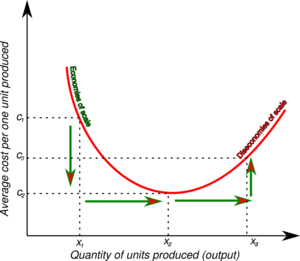Economies of scale
| Economies of scale |
|---|
| See also |
Economies of scale in microeconomics shows decreases of unit cost of production relative to the size of the production, at the same time it indicates the benefits of mass production. Increase in the volume of production (scale of production) decrease the long-term average total costs (e.g. electricity costs, advertising) which break down on the increased number of units produced. Through the economies of scale company gets greater bargaining power, it can thus apply strategy of low prices and keep the high barriers of entry to the market. Fig. 1. presents this phenomenon graphically.
Benefits of economies of scale
The phenomenon of economies of scale is causing following advantages:
- declining average total costs,
- better access to sources of funding (e.g. loans),
- possibility to use new technologies and knowledge that is associated with the purchase of modern machinery and equipment needed for large scale of production,
- use specialized management techniques adapted to the industries in which the company achieves high economies of scale,
- better conditions for cooperation with other parties (in oligopoly),
- better utilization of labour market in a particular region,
- better division of labour.
Companies should strive to achieve the economies of scale, because it increases the competitive position of the company on the market, leadership in terms of cost, prices, quality, etc.
See also:
References
- Koshal, R. K. (1972). Economies of scale. Journal of Transport Economics and Policy, 147-153.
- Krugman, P. (1980). Scale economies, product differentiation, and the pattern of trade. The American Economic Review, 70(5), 950-959.
- Panzar, J. C., & Willig, R. D. (1977). Economies of scale in multi-output production. The Quarterly Journal of Economics, 481-493.
- Pratten, C. F. (1971). Economies of scale in manufacturing industry. University Press.
- Stigler, G. J. (1958). Economies of Scale, The. JL & Econ., 1, 54.
